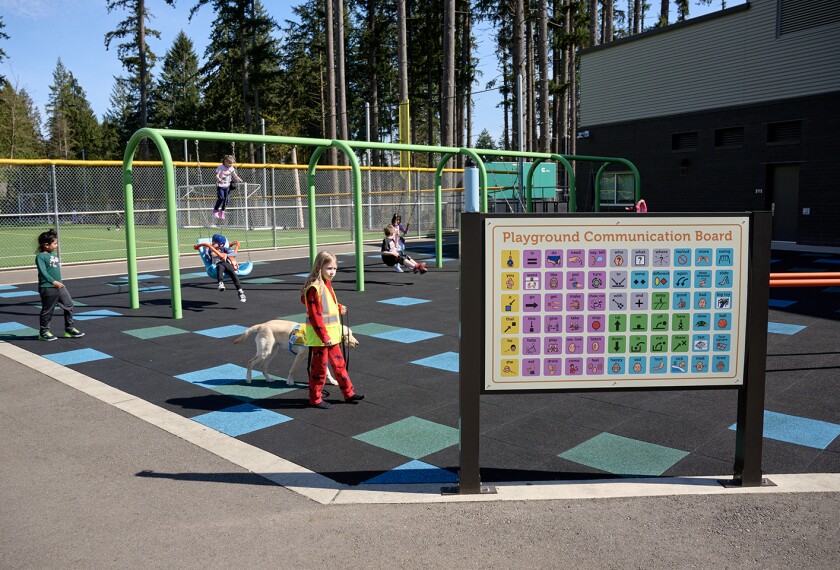Saying Illinois has ignored its duty to monitor Chicago’s treatment of students with disabilities, a federal court has found the state education department liable for the segregation of disabled students in the Chicago public schools.
The school system has repeatedly placed disabled students in “separate and unequal educational environments,” and the Illinois state school board abdicated its responsibility to force the district to change its procedures to comply with the federal law, U.S. District Court Judge Robert W. Gettleman of Chicago wrote in a decision handed down last month.
The strongly worded decision will affect nearly all of the 50,000 disabled children in the 420,000-student Chicago district, the nation’s third largest, and leaves the state to come up with a plan for revamping its monitoring and funding of special education.
It also breaks ground on several fronts, special education lawyers said. It’s the first ruling to hold a state at fault for the special education decisions of an entire district--let alone one as large as Chicago, said Sharon Weitzman Soltman, a lawyer with Designs for Change, a Chicago school advocacy group that helped argue the case along with the Northwestern University Legal Clinic.
“This looks not just at a particular child’s placement, but looks systematically at a large school district,” said Jay P. Heubert, a special education lawyer and assistant professor at Harvard University’s graduate school of education.
“It’s the most comprehensive lawsuit that focuses on the failure of a large urban school district to educate disabled children in the least restrictive environment, as federal law has required,” he said. Mr. Heubert reviewed the case as an expert for Designs for Change. Although the case only examined the state’s relationship with the Chicago district, Mr. Heubert said it could have implications for all Illinois districts.
Placement by Disability
A group of disabled students and their parents filed Corey H. v. Chicago Board of Education and Illinois State Board of Education in 1992 as a class action. Chicago officials previously settled their portion of the case and have agreed to create a more inclusive environment for disabled students.
Thomas Hehir, director of the U.S. Department of Education’s office of special education programs, was an associate superintendent in Chicago from 1990 to 1993. In an interview, he said that Illinois had a history of IDEA placement violations, but that the Chicago district had made big strides in correcting its problems in recent years.
The OSEP has warned that it plans to watch state monitoring efforts more closely. (“IDEA Rules Are Hot Topic at State Spec. Ed. Directors’ Meeting,” November 26, 1997.)
A 1994 study, which neither state nor district officials contested, found that Chicago officials had based their decisions about educating students with disabilities on the category of a child’s disability, rather than a child’s individual needs.
Under the federal Individuals with Disabilities Education Act, states are charged with distributing federal special education dollars and monitoring their districts to ensure that schools educate disabled students in the “least restrictive environment.”
According to the federal court, however, Illinois seemed oblivious to Chicago’s practice of keeping most of its students with disabilities in segregated environments, and to the fact that many of the Chicago district’s policies conflicted with the IDEA. What’s more, the court found, the state’s formula for distributing federal aid to districts encouraged schools to place disabled students in segregated environments.
“The Chicago public schools have languished in an atmosphere of separate and unequal education for children with emotional, behavioral, and mental disabilities,” Judge Gettleman wrote Feb. 19.
For instance, even though up to 90 percent of mildly mentally retarded students were capable of spending most of the school day in a regular classroom, only 15 percent to 22 percent of those students spent more than half the day in such a setting, according to Chicago officials who testified in the case.
Remedies Planned
In court, the Illinois state school board had argued that the state was not responsible for the day-to-day implementation of each child’s individualized education plan. But the court said that was irrelevant, and that the issue at the heart of the case was the state’s monitoring of Chicago.
Tom Hernandez, a spokesman for the board, refused to comment on the specific charges. He said the board had not decided whether to appeal.
The judge ordered the state board to draw up a remedial plan by April 17. The plan must address ways to correct the violations, including changing the state formula for passing federal funds to districts, and will determine whether a court will monitor the state’s progress.
Under a settlement with students and parents approved in January, the Chicago school board agreed that, over the next eight years, the district will spend $24 million to train teachers and create a more inclusive environment for disabled students. That includes considering the regular education classroom as the first option in placements of disabled students, the agreement stipulates.




